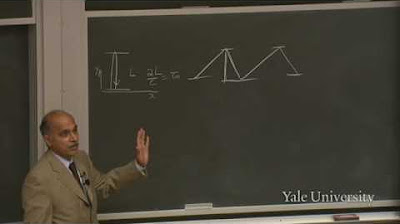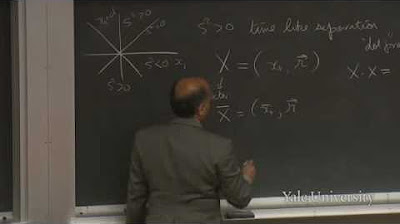12. Introduction to Relativity
TLDRIn this transcript, Professor Ramamurti Shankar delves into the principles of special relativity, emphasizing the constancy of the speed of light and the relativity of motion between inertial observers. He discusses the historical context, from Newton's laws to the Michelson-Morley experiment, leading to Einstein's revolutionary postulates. The lecture explores the implications of length contraction and time dilation, culminating in the derivation of the Lorentz transformation, which reconciles the observed phenomena with the principle of relativity.
Takeaways
- 🌟 The two theories of relativity are special relativity and general relativity, with special relativity focusing on the laws of physics being the same in any two inertial frames of reference and the constancy of the speed of light.
- 🚄 The principle of relativity states that uniform motion between two observers, both inertial, is relative and neither can claim to be at rest while the other is moving.
- 🔍 The Michelson-Morley experiment showed that the speed of light is constant and does not vary with the motion of the observer, contradicting the expectations of Newtonian physics.
- 🌌 The concept of 'ether' as a medium for light waves was disproven, as experiments showed that the Earth's movement through space did not affect the measured speed of light.
- 💡 Einstein's first postulate of special relativity is that all inertial observers are equivalent, meaning they can all discover the same laws of nature.
- 📏 Einstein's second postulate is that the velocity of light is independent of the state of motion of the source or the observer, and is the same for all observers.
- 🔗 The Lorentz transformation is the mathematical relationship that connects the coordinates of an event as observed in different inertial frames of reference.
- 📐 The Galilean transformation is the old rule for connecting space-time coordinates between different frames of reference, which is replaced by the Lorentz transformation in the context of relativity.
- 🚀 No observer can travel at a speed greater than the speed of light, which is a fundamental limit on possible velocities in special relativity.
- 🕒 Time dilation is a consequence of special relativity, where moving clocks run slower compared to stationary ones, as observed from the perspective of the moving observer.
- 📏 Length contraction is another consequence of special relativity, where objects in motion appear shorter in the direction of motion to a stationary observer.
Q & A
What are the two theories of relativity mentioned in the transcript?
-The two theories of relativity mentioned are the special theory of relativity and the general theory of relativity.
What is the fundamental postulate of the special theory of relativity?
-The fundamental postulate of the special theory of relativity is that the laws of physics are the same in any two references moving in uniform motion relative to one another, and the speed of light is constant in all references.
Why does the professor mention Newton in the context of relativity?
-The professor mentions Newton to illustrate that the idea of relativity is not new; there was a theory of relativity at the time of Newton, which is where the discussion begins.
What is the thought experiment with the high-speed train intended to demonstrate?
-The thought experiment with the high-speed train is intended to demonstrate the principle of relativity, specifically whether one can detect uniform velocity in a closed system without looking outside.
What is the significance of the speed of light being constant in all references?
-The significance of the speed of light being constant in all references is that it supports the principle of relativity, meaning that the speed of light is the same for all observers, regardless of their relative motion.
What does the professor mean when he says 'the laws of Newton will be unchanged when this velocity is added on to you'?
-The professor means that when a constant velocity is added to an observer, the laws of Newtonian mechanics, such as F=ma, will still hold true and will not be affected by the addition of this velocity.
How does the principle of relativity apply to the perception of motion between two trains?
-The principle of relativity applies to the perception of motion between two trains in that an observer in either train cannot definitively determine whether it is they or the other train that is in motion; both can claim to be at rest with the other in motion.
What is the Galilean transformation mentioned in the transcript?
-The Galilean transformation is the classical rule for the transformation of coordinates between two inertial frames of reference, where the time is considered universal and the space coordinates are adjusted by the relative motion between the frames.
What is the significance of the Michelson-Morley experiment in the context of the speed of light?
-The Michelson-Morley experiment is significant because it showed that the speed of light is the same for all observers, regardless of their relative motion to the light source, which contradicted the expectations of Newtonian physics and led to the development of the theory of relativity.
How does the concept of 'length contraction' relate to the theory of relativity?
-Length contraction is a concept in the theory of relativity where lengths in the direction of motion are measured to be shorter in the moving frame of reference compared to a stationary observer's frame, which is a consequence of the constancy of the speed of light.
What is the Lorentz transformation?
-The Lorentz transformation is a set of mathematical equations that relate the space and time coordinates of an event as observed in two different inertial frames of reference moving relative to each other, taking into account the constancy of the speed of light.
Outlines
📚 Introduction to the Theory of Relativity
Professor Ramamurti Shankar introduces the concept of special relativity, distinguishing it from general relativity. He begins by querying the students' understanding of relativity, highlighting that it's about relative speed in two reference systems. The discussion revolves around the fundamental postulates of special relativity, including the constancy of the speed of light and the principle that the laws of physics are the same in all inertial frames.
🚄 The Paradox of Uniform Motion
The professor delves into the paradox of uniform motion, using the analogy of a high-speed train to illustrate the concept. He poses the question of whether one can discern movement while in a uniformly moving train. The key point is that without external references, it's impossible to determine if one is moving or not, emphasizing the relativity of motion and the inability to perceive uniform velocity in a closed system.
🌌 Historical Context of Relativity
Professor Shankar provides historical context by discussing the pre-Einstein theories of relativity, noting that the concept is not new but has evolved over time. He explains that the principles of special relativity were understood even before Einstein, with the laws of physics remaining constant in inertial frames, as established by Newton's laws of motion.
🔍 The Event and Space-Time
The lecture shifts to defining the concept of an 'event' in the context of space-time. The professor explains that an event occurs at a specific place and time, and to describe it accurately, one needs coordinates for both space and time. This leads to the introduction of the x and t axes, representing space and time, respectively, and the concept of labeling events within this framework.
🔄 Galilean Transformation
The professor discusses the Galilean transformation, which is the classical method of relating the coordinates of events as observed by two different inertial frames of reference. He explains how the time is universal across observers and that the velocity of light is expected to appear different when measured from moving frames according to Galilean principles.
🌠 The Michelson-Morley Experiment
The discussion turns to the Michelson-Morley experiment, which aimed to detect the Earth's motion through the 'ether' by measuring the speed of light. The unexpected result was that the speed of light remained constant regardless of the Earth's motion, challenging the Galilean transformation and leading to a fundamental question about the nature of light and the ether.
💡 Einstein's Principle of Relativity
Einstein's revolutionary postulates are introduced, asserting that all inertial observers are equivalent and that the speed of light is constant for all observers, regardless of their relative motion. These postulates defy the expectations set by Newtonian physics and open the door to a new understanding of space and time in the context of relativity.
📐 Derivation of the Lorentz Transformation
The professor outlines the derivation of the Lorentz transformation, which provides the mathematical framework for understanding how space and time coordinates change between inertial frames. The transformation emerges from considering the behavior of light and the need for a new set of rules that differ from the Galilean transformation, especially at velocities approaching the speed of light.
🌟 Implications of the Lorentz Transformation
The implications of the Lorentz transformation are discussed, emphasizing that while the coordinates of events may differ between observers, the underlying laws of physics remain the same. The professor clarifies that the transformation relates the coordinates of the same event as observed from different inertial frames, and that these new rules are essential for understanding relativity at high velocities.
Mindmap
Keywords
💡Special Relativity
💡Inertial Frames
💡Speed of Light
💡Galilean Transformation
💡Lorentz Transformation
💡Time Dilation
💡Length Contraction
💡Relativity Principle
💡Newtonian Mechanics
💡Michelson-Morley Experiment
Highlights
Introduction to the two theories of relativity: special and general, with a focus on the special theory.
The concept of relative speed in two reference systems and the postulates of special relativity.
The historical context of relativity, tracing back to Newton's time.
The thought experiment of the high-speed train to illustrate the principle of relativity.
Discussion on the inability to detect uniform velocity in a closed system.
The difference between inertial and non-inertial frames of reference.
The principle of relativity stating that uniform motion between two observers is relative.
The explanation of the Galilean transformation and its consequences.
The concept of an event in space-time and its significance in understanding relativity.
The relationship between the coordinates of an event as perceived by different observers.
The discussion on the constancy of the speed of light and its implications for relativity.
The explanation of the Michelson-Morley experiment and its results.
Einstein's postulates on the principle of relativity and the constancy of the speed of light.
The derivation of the Lorentz transformation and its significance in special relativity.
The impact of the Lorentz transformation on the concepts of space and time.
The explanation of how the speed of light is the upper limit on possible velocities.
The discussion on the symmetry between observers and the implications for length and time measurements.
The conclusion that all natural laws are obeyed equally by all inertial observers, regardless of their relative motion.
Transcripts
5.0 / 5 (0 votes)
Thanks for rating:





